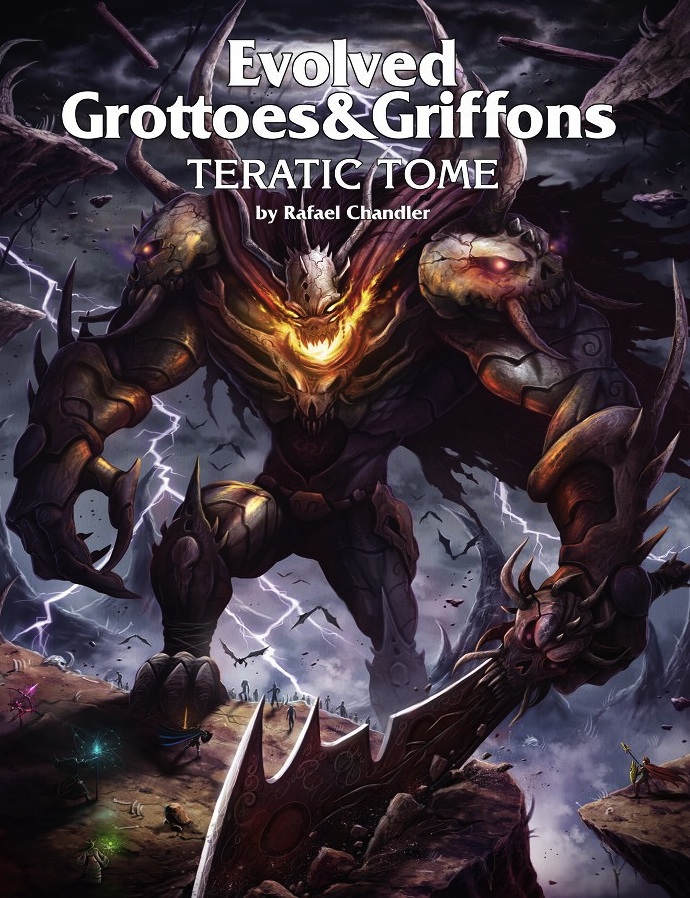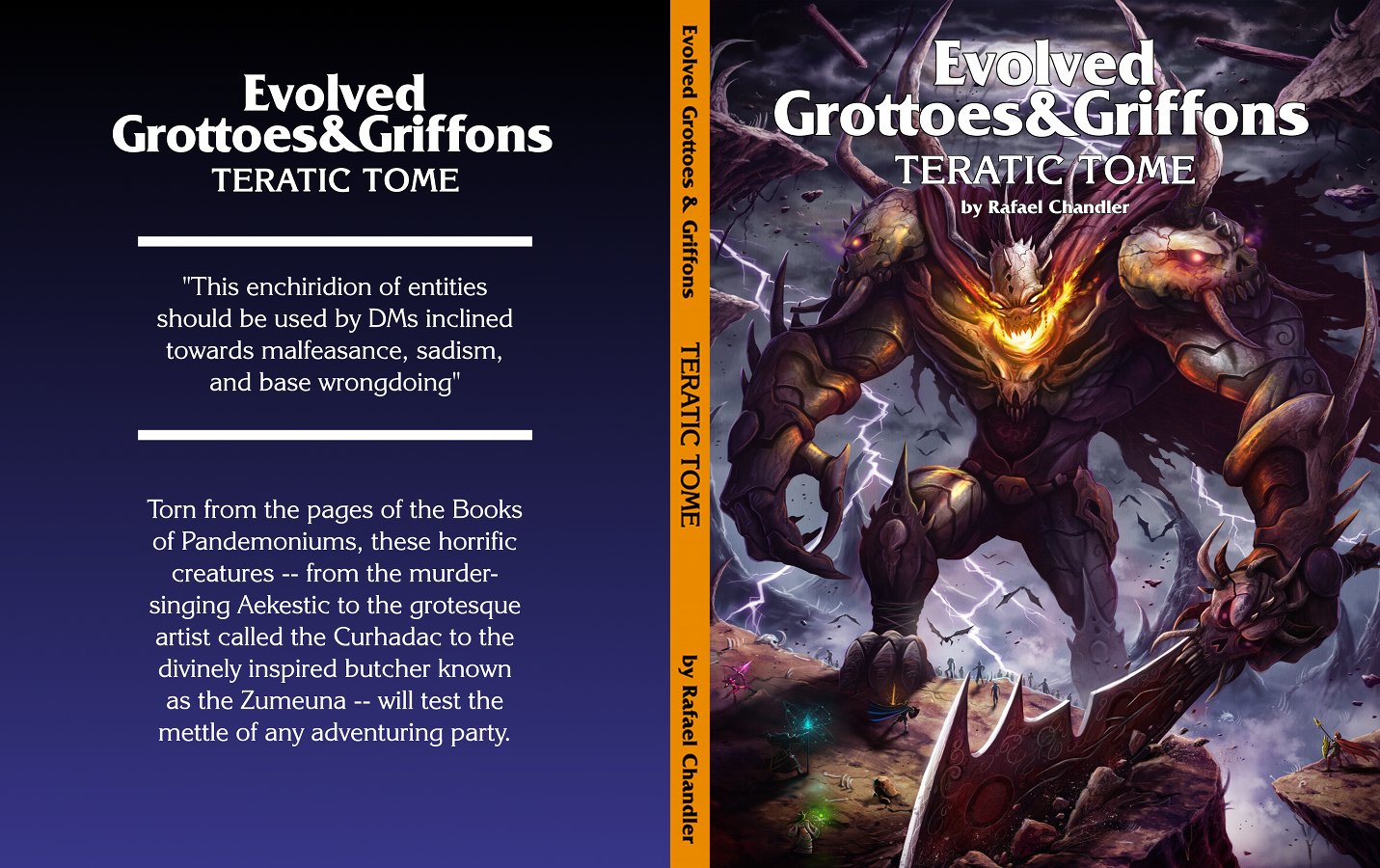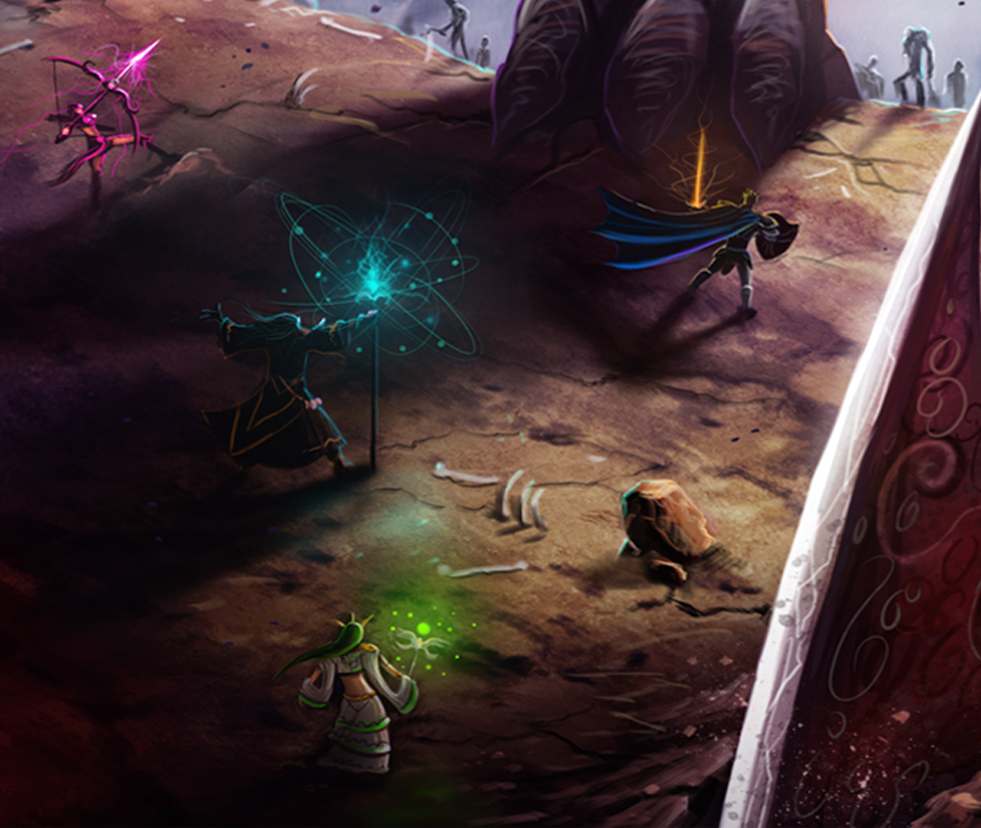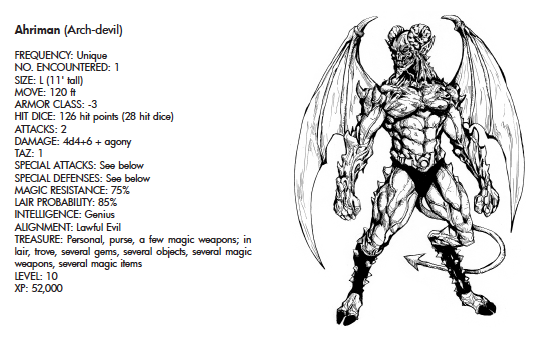I don’t do a lot of reviews. I should probably do more, actually, I certainly read enough RPG material.
Short form: holy balls is this an impressive book. If you like old school and you like freakishly scary and horrifying monsters, BUY THIS BOOK!
A few weeks ago Rafael Chandler posted a picture to Google+ of the cover of his soon-to-be-finished book.
That is badass. (The description of the creature later is even more so, and I’ll come to that later.)
Actually, let’s look at the actual image he posted.
The front cover certainly caught my eye, but that orange spine and gradient on the back is… evocative of an earlier time in my life, let us say. He also gave a detailed snapshot of part of the cover:
Yes, that monster on the cover is that big. Those little lights you see in the bottom-left corner of the front cover are mighty heroes who presumably question their choice of career right now.
Badass art, old school presentation, definite problems for ‘the good guys’? Mr. Chandler, at this point you had my attention. Firmly.
Now let’s take a look at the inside.
Definitely consistent with the old school in presentation.
Reading the monster descriptions — I bought the hardcover from Lulu, the thank you email included a link for a free PDF download of the book; I ended up printing and binding this at home because I didn’t want to wait.
Impatience pays off sometimes, and this is one of those times.
The book is laid out in old style fashion, all internal art is monochrome — some line art, some grey scale — and the monster descriptions start right after each other rather than each starting on its own page. Normally I favor monster books that start each monster on its own page, but this let Rafael fit more in the same space, and it entirely fit the tone of the book.
The content, though? Scary monsters. I don’t mean high-level threats, though the book is heavily weighted that way. I don’t mean difficult Armor Class and high damage attacks. I mean monsters that actually evoked visceral “oh my gods I don’t want to meet one of those” reaction in me.
The kind where just one of these creatures could legitimately raise an “oh shit, that’s what happened! Is it still around?!” reactions in players when they discover what’s been going on. Or possibly better yet, “that is what is happening, can we stop it?!” reactions.
This is perhaps the book filled with the most monstrously monsters I have ever seen. I don’t mean disgusting, as I found much of the content of Carcosa, which struck me as more playing for shock value, I mean actually horrifying in what they do… and credibly so.
I won’t list examples here because honestly, I inhaled this book over about two nights and the individual entries are jumbled together in my brain right now. My reaction, though, throughout the book, was of stunned fascination with how monstrous these monsters are. Literally so, they are inhuman in their drives and goals. Physically I can imagine them evoking horror and terror upon being seen in true form (many of them can shape change to blend in, or inhabit their victims — or dupes — while committing their deeds). That they are dangerous is without question, but how they go about it is horrifying.
Come to that, something else in this book that impressed me, and that I’d never much considered, was the presence of omens and early indicators. Some of the highest-level creatures had descriptions of what might be seen where they are going to appear.
During the days before Pantagruel’s [the giant from the front cover] return, horrific phenomena will transpire:
- Animals are torn apart from within by hives of insects growing in their bowels
- Strange people with cadaverous grins wink and wave from inside mirrors
- Fluids slide up walls and across ceilings in defiance of gravity, then rain up into the sky
- Knives fling themselves from kitchen drawers and hurl themselves at people
- Statues lunge from their pedestals and devour children
- Laughter is heard in empty rooms, and then it turns into screams of utter agony
- Healthy and friendly animals suddenly attack their masters (or themselves)
- People vomit up living things which crawl away
- Paintings speak, telling of horrible calamities yet to come, then commit suicide
This is what happens when he is just coming to a place. And they suit the creature — Pantagruel was a legendary giant noted for his cheerful demeanor and gentle pranks who disappeared on a voyage to the west centuries ago… and came back changed, and “he now destroys everything he sees, obliterating all life to protect living creatures from the horrors yet to come”.
I want to know more. If this is what he does out of mercy, how bad is what is coming?
Which raises something else I like about this book. In many places there is clear indication of more, things that are not yet described in detail, but are identified and described enough to make me want to learn more. Rafael has mentioned plans, for example, to expand on Mictlan, the place of devils and where they are at war with something presumably worse).
I have to mention another semi-mechanical bit I really appreciated, the way Rafael handled treasure. Rather than arbitrary treasure types identified by letter (as AD&D did) or level-based treasure (as D&D 3.x and after did), here he just describes the treasure in a standardized form using defined terms.
For coins (copper, silver, electrum, gold, and platinum):
assortment d10 cp, d10 sp, d10 ep cache 3d20 cp, 3d20 sp, 2d10 ep, d10 gp coinage d100 cp, d100 sp, 2d20 ep, d20 gp fortune d100 ep, d100 gp, d20 pp hoard d10,000 cp, d1,000 sp, d100 gp loot d100 sp, d100 gp, 5d10 pp lucre d1,000 cp, d1,000 sp, d1,000 ep, d1,000 gp purse d100 gp, d100 pp riches d10,000 sp, d10,000sp, d1,000 ep, d10,000 gp, d100 pp trove d10,000, d100,000 sp, d10,000 ep, d10,000 gp, d1,000 pp For jewels, gems, scrolls, potions, and magic items:
few d4-1 many d8-1 numerous d12-1 several 2d10-2
I might have chosen different words for each (I might have gone ‘few, several, many, numerous’ for items), but a monster entry that lists as treasure “personal, assortment, a few gems; in lair, hoard, many objects, a few magic items’ is remarkably easy to understand. With only a bit of work I can assimilate the tables above and know pretty quickly what treasure descriptions like this mean.
There are a few flaws in the content, a couple places where I found inconsistencies (the height of the giant on the cover is 100′ or 200′ depending which bit of text you look at, and it does 2d10 or 4d12 hit points of damage per attack but I did not see a description of when you use one or the other damage value) but as far as I can tell these are not common. The book often uses value ranges rather than dice expressions for things, which takes me a moment to figure out (5-15 points of damage — which I make to be 2d6+3)… not a big deal, and will come back to me soon enough.
Partial nudity shows up a lot. I think it appropriate, both from the ‘old school aesthetic’ point of view and in the reaction it got. These aren’t like the succubus picture you liked so much in the Monster Manual (“Fun Fact: 90% of used bookstore copies of the old D&D Monster Manual, when dropped onto a bed, spine first, will fall open to page 17” [i.e. “the page with the Succubus drawing”] — Doc Black), these actually got “oh man, that’s terrible” reaction from me — which is evidently exactly what Rafael was looking for. My primary negative reaction to these choices in art direction was that it was inconvenient: I couldn’t read this online during my lunch break at work in case someone saw it on the monitor, and I felt it prudent to cover up some of the monster pictures in my hardcopy so I could read it on the bus. I do not feel it is useless cheesecake to cover the absence of content of value, I think the pieces are well-executed and well-chosen… but it was inconvenient.
I like this book. I can’t wait to apply it to my game. Honestly, I’m not sure I’m up to playing these monsters the way they deserve to be played… and that pleases me.




Damn! :) Thanks so much! I really appreciate the kind words about the omens and treasure — worked hard on those, and I’m glad it turned out okay.
On an Echelon-related note, I like how each of the characters obviously has his own magical “mojo” as you like to put it. Good use of colour in the special effects, the different-coloured glows indicate different people having their own powers.
Are there any magic items tied in to the monsters? Like the good old cliché of the magic gem/amulet which is protected by a gribbly monster who hunts down anyone that touches it.
Hey, I just noticed the fifth guy off to the right!
Hi, GreyKnight. I can’t think of any magic items tied into the monsters, though the Curhadac does create some lovely paintings and the Xarualac has been known to create some wonderful musical instruments (true story).
oh man, Xarualac. That’s one creepy sumbitch.
Mind you the Seamstress is a little discomfiting as well…
I’ll tell the wife. She’ll be delighted that her creation has caused discomfiture!
Pingback: Teratic Tome Takeaways | Keith Davies — In My Campaign - Keith's thoughts on RPG design and play.
Pingback: Neoplastic Press or Nerd-Crush, You Decide | Keith Davies — In My Campaign - Keith's thoughts on RPG design and play.
Pingback: Teratic Monster Design | Keith Davies — In My Campaign - Keith's thoughts on RPG design and play.
Oh, as if seeing the orange spine wasn’t enough this review just makes me want the book NOW. I’ll be porting it to 13th Age…
And for THAT PRICE?
I hope you’ll enjoy it, I certainly have.
Pingback: Horrific Monster Book: Lasus Naturae | Keith Davies — In My Campaign - Keith's thoughts on RPG design and play.
I just got my copy today and HOLY CRAP. Believe. The. Hype. BUY THIS BOOK!!! Thanks for turning me onto this guy’s work, kjdavies!
You’re welcome, Todd. I’m glad you like it.